| This year I was a guest of Yamaha for the NAMM show. My wife, Karen, was with me one of the two days I attended. We met up with our musician son, Elliot too - and I ran into many people I know during my wondering around the exhibit halls. The weather was also perfect this year. |
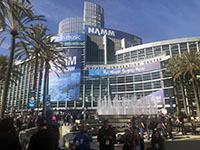 |
| I have not shown much in prior years about the various musical groups that add to the excitement at NAMM. Here is one of the headliners for 2020: Tower of Power. They are behind a black screen because there were doing sound checks when I walked by. Their concert was in the evening - and I usually do not stay for the evening events. |
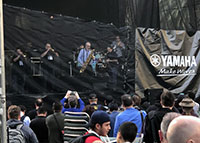 |
| He is the Boston Brass performing at the Yamaha exhibit. This is a great brass quintet that specializes in pop and jazz rather than classical music. Those of you who can count may notice there are six musicians in the photo. This is because they invited Jens Lindemann to sit (stand) in. I recognized Jens as soon as he emerged from the crowd - but it was his red and blue trumpet that really jarred my memory. Jens was our guest soloist last year at the Caltech Occidental Wind Orchestra concert at Occidental College. |
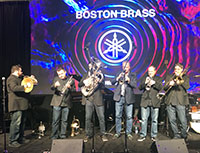 |
| Here is the Langley Ukulele Ensemble playing on the main exhibit room floor - congregating around a booth that had some ukuleles! |
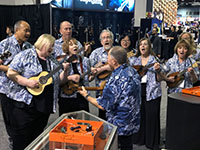 |
| Of course, this is the era of social media - so people were posing and doing interviews beside a huge "Hash-tag NAMM Show" signs outside the convention center. |
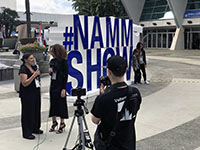 |
| One of the complaints everyone has about the NAMM show is that it is really loud there. Although this is a natural byproduct of a show that exhibits musical instruments, sometimes (often) things get carried away when adjacent exhibits are competing to be heard. Each day there was an email to all registered NAMM participants warning us to keep the volume down. Evidently, there are indeed consequences, as shown here. This exhibitor was evidently shut down for producing excessive noise levels. Given how loud everything was in other areas - I wonder how loud these people were? |
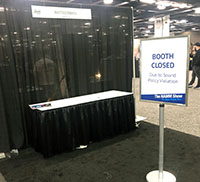 |
| Here I am trying out a new plastic slide wind instrument from Antigua pInstruments. It is sort of a soprano trombone. It was playable, but sort of silly. |
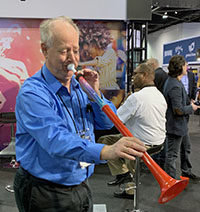 |
| Not all small instruments are silly - though most really are. Here I am playing a sopranissimo saxophone from J'Elle Stainer. This is even smaller (higher, more expensive, and more obnoxious) than the sopranino sax I often play with jazz groups. It is a real instrument, though. The booth also featured bass and contrabass saxophones. |
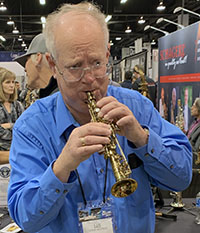 |
| This booth was in a corner, out of the way, in the hall that contained most of the wind instruments. The man looked lonely so I stopped by to try out his trumpets. This was quite a surprise as these turned out to be some of the best trumpets at the show! Thane is his middle name. His badge shows that he is Logan Brown - actually Logan Thane Brown. NAMM left off his middle name even though it is the name of his company! Logan worked for years at Monet so he knows how to build great trumpets. He builds all of his trumpets himself by hand. My son Elliot, who is a professional trumpet payer, agrees with me that these are fine horns. |
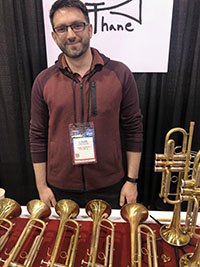 |
| In the category of "what is that thing" my wife, Karen, is modeling a double-belled trumpet from Tianjin Master Imports and Exports - clearly a Chinese company. I have seen and played several double-belled trumpets over the years. All the others have two quite different bells, so the player can switch quickly between very distinct sounds. These two bells appear to be identical in size and bore - so they would have very similar tone. Hence, I wonder why they made this? Perhaps you are expected to put a mute in one of the bells... |
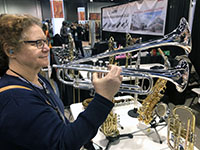 |
| Here is the mPiano. Its keyboard is custom made by Laukhuff, one of the premier suppliers of organ keyboards. It has a great feel. However, what makes this special is that it has embedded sensors that measure where you fingers are along the keys and the depth of the key travel. They have software tat allows you to modify the sound based on these parameters. It is one interesting way to create a second touch organ effect. |
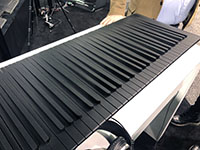 |
| This upright piano as been retrofitted with a huge custom computer screen by QRS Pianos. Their main application is music education - though you can also use this to display your music library. |
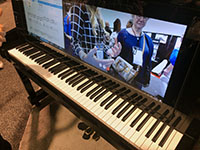 |
| Here is a very simple product that could become very popular. Ukeys builds key overlays that attach using a 3M reusable adhesive similar to what is found in Post-Its. The overlays come in bright colors and shiny surfaces to add pizazz to any keyboard. |
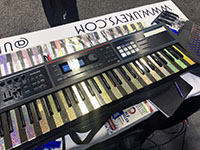 |
| Here is a strange looking bass drum from Trixon Vox Drums. I wonder how hard it will be do find replacement heads in the future! |
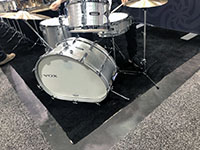 |
| The strange looking set of wire rigging is the Welsh Tuning System (WTS) for drums. A single twist from a drum key modifies the tension on both drum heads simultaneously. It sounds like a great idea - like the tuning systems on the old Arbiter drums. |
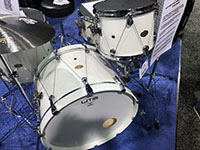 |
| Holy Zildjian! Need I say more? |
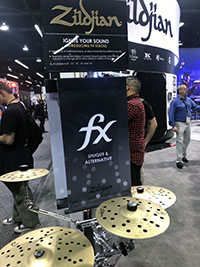 |
| Here you see Karen demonstrating the Duo-Tone tympani mallets from Black Swamp. They have two distinct hardnesses on each side, so rotating them produces different tones. |
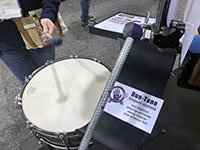 |
| In case you are wondering what you are supposed to do when you have completely destroyed that rock cymbal on your drum set - here is one answer. An artist at Full Circle can turn that old, cracked cymbal into fine artwork or jewelry! I thought this was one of the most creative percussion exhibits at NAMM. Unfortunately, it was hard to admire the fine workmanship or converse with the artist since they were surrounded by loud percussion all around their booth! |
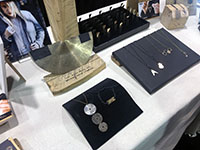 |
| NAMM had an aisle of custom artwork guitars on display. I have no idea if any of these actually play well - but they sure looked great. This one was Karen's favorite - from Boutique Guitar. |
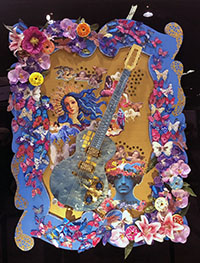 |
| Here is a booth of fancy art guitars from Spalt. Some of these were so complex that I couldn't determine where that placed the tuning pegs for the strings! |
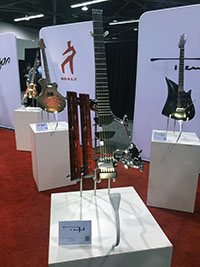 |
| I have no idea if Traveler Guitars are great instruments - but their booth was quite memorable. Rather than displaying in an exhibit hall, they set up outside between convention center buildings. They even had a cool Airstream Trailer as a sales office. |
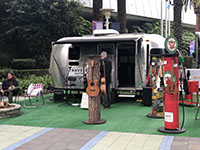 |
| Teisco is back! For those of you who have no idea what I am talking about, In the 60s and 70s, many piano and organ companies formed subsidiaries for pop instruments so they would not tarnish their reputation for classical products. Kawai purchased a small company called Teisco to produce rock instruments like synths, guitars, and effects boxes during this time. My wife, father, and I visited Teisco outside of Tokyo back then and I even played a short organ concert on an 8-manual and pedal synth they had built. I still own a Teisco analog monophonic synth. Today, the Teisco name (and likely the intellectual property) is part of a large Singapore-based music company called Harmony. Their salesman was proud of the fact this this new delay box is "analog and all hand-soldered." |
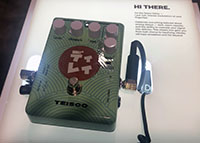 |
| Here is yet another hand-soldered analog delay box! This one has the somewhat cool name "Delay Llama." Ha ha! |
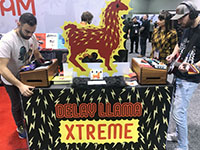 |
| Several displays of effects boxes for guitars also had some Altoids boxes. I spoke to one of the exhibitors and confirmed my suspicion. These are A/B switches that allow the demonstrators to switch various boxes in and out to the audio path so as to isolate various sounds. They are placed in Altoids boxes because these are handy, small, and inexpensive Faraday cages! This means that, since they are all metal, electric interference cannot get from the outside to the components inside. Besides, as one exhibitor admitted, you get to eat something tasty before you build them. |
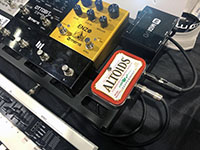 |
| And kits are making a comeback! I remember an era when musical instruments kits (for synths, organs, amplifiers, ...) we a common way to save money. This company, NuTekt, sells kits for small synthesizers and effects boxes. No soldering is required, as the circuit boards come fully populated. At least NuTekt knows (as do I) that hand-soldering is not necessarily a good selling point. Once you have constructed one of these, they have a library of open source software you can download for all sorts of upgrades. Oh, and you don't actually have to use the silly little keyboard on this box - these all have MIDI interfaces too! |
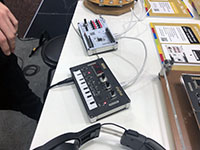 |
| These two nice women are giving me a private demonstration of the Beacon 2 portable sound system. The base contains a four channel mixer and amplifier. The speakers fold out - except for the sub-woofer that is contained in the base. Everything is mounted on a nice dolly too - and its not too heavy. |
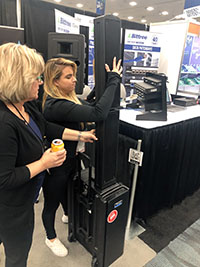 |
| No, this man is not vacuuming up after some messy NAMM attendees. He is demonstrating the k-Array, a flexible tube filled with small speakers. When used together with its stationary sub-woofer, this produces quite a good sound. Because it is flexible and modular, you can string these up quickly in some vary interesting configurations. |
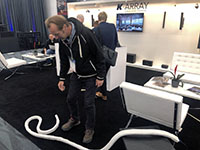 |
The Moog Foundation is collecting donations to support the MoogSeum and its various educational enterprises. I really enjoyed the donation box that is made out of an old Therimin! Karen and I were celebrities at this booth too - because of our name. We are related to Herb Deutsch, who was a close friend and co-inventor with Bob Moog. In fact, Herb introduced us all to Bob at a NAMM show many years ago. |
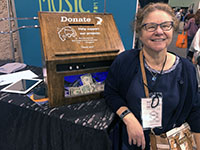 |
| There are not many organ exhibits at NAMM nowadays. When I first started attending NAMM in the 70s, there were hundreds of organ booths and the larger companies even had private soundproof rooms. Today, there are just a handful of organs on the floor in noisy places and mostly getting ignored. This booth almost qualifies as an organ booth though! It is from Inspired Acoustics. I found them along a wall ad next to a huge and very loud exhibitor. Despite the noise level, I had a good conversation with the owner about reverberation modeling. It was clear he new some mathematics. When I asked if he had considered applying some of this to digital organs, he showed me a brochure for their organ products. I then realized I already knew about this company and this man. He is Csaba Huszty, a developer of Hauptwerk organ sample sets from Hungary. I have even corresponded a bit with him in the past. |
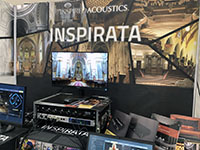 |
| Here is a booth advertising the NAMM Museum of Music. This museum has existed for years in Carlsbad - near San Diego. In November, my daughter, Erica, and I visited the museum for the very first time. They had an interesting exhibit to teach people how analog synthesizers work. It involved carrying a small piece of wood from table to table, where information was added to it (on some sort of chip inside). At the end, you place the object on the final table and play its sound from a keyboard. However, the day we were there, something had malfunctioned and nothing would play. Well, here at this very booth, NAMM chose to bring that specific exhibit - and the exhibit's designer was piloting the booth. I was actually able to complain to him about the malfunction. He was aware of that issue - and had already fixed it. |
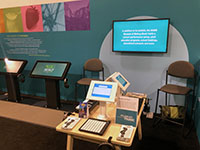 |